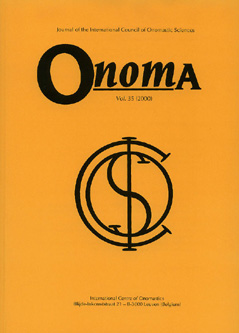 previous article in this issue previous article in this issue | next article in this issue  |

Preview first page |
Document Details : Title: Name Theory and Set Theory Subtitle: The Return of the Maximum Meaningfulness View of Names Author(s): VAN LANGENDONCK, Willy Journal: Onoma Volume: 41 Date: 2006 Pages: 45-62 DOI: 10.2143/ONO.41.0.2119610 Abstract : Hansack and Brendler advocate a 'cognitivist' view of language and of names based on the natural sciences, set theory and logic. In this paper, I will focus on their use of set theory and their actual neglect of grammar, and the consequences thereof for name theory. Both authors claim that the linguistic sign is a form that indicates some meaning or other in the brain, but does not carry, transport or contain it, as Saussure would have it. Both proper and common nouns are linguistic signs in this sense. In order to define these signs as two different subcategories, set theory is adduced. This is claimed to allow us to view both kinds of noun as words referring to classes of objects. The difference lies merely in the number of elements in the classes: a one-element class meaning and a more-than-one-element class meaning. Both therefore have in common that they refer to a class with a meaning, and proper nouns are not 'empty'. Hence no distinct 'kinds' of meaning are distinguished. No distinction is made between semantic features and knowledge. In the case of proper names, this view inevitably leads to the maximum meaningfulness thesis: that the meaning of names appears to be (almost) infinite. Whilst the 'empirical' view of linguistics as an exact science is perfectly legitimate, there are other views that are certainly just as empirical and which are strongly supported by linguistic findings. It is by this more inductive approach that my criticisms of the above deductive framework are mainly inspired. However, certain ideas in common between Hansack, Brendler and myself are noted. Hansack et Brendler prônent un point de vue cognitiviste de la langue et des noms sur la base des sciences naturelles, la théorie des ensembles et la logique. Dans cet article, je me concentre sur leur utilisation de la théorie des ensembles et leur négligence réelle de la grammaire, et les conséquences pour la théorie des noms. Les deux auteurs affirment que le signe linguistique est une forme qui indique un sens ou un autre dans le cerveau, mais n’en porte pas, ni n’en transporte, ni n’en contient, comme Saussure l’aurait voulu. En ce sens, les noms propres et communs sont des signes linguistiques. Afin de définir ces signes comme deux sous-catégories différentes, la théorie des ensembles est mise en oeuvre. C’est affirmé pour nous permettre d’afficher deux types de nom comme mots faisant référence à des classes d’objets. Cette différence réside simplement dans le nombre d’éléments dans les classes: un sens de classe à un élément et un sens de classe à plus d’un élément. Les deux ont donc en commun de se référer à une classe avec un sens, et les noms propres ne sont pas 'vides'. Par conséquent, aucun 'type' de sens différent ne peut être distingué. Aucune distinction n’est faite entre les traits sémantiques et les connaissances. Dans le cas des noms propres, ce point de vue conduit inévitablement à la thèse de la signification maximum: la signification des noms semble être (presque) infinie. Alors que le point de vue 'empirique' de la linguistique comme une science exacte est parfaitement légitime, il existe d’autres points de vue qui sont certainement tout aussi empiriques et d’ailleurs fortement soutenus par les résultats linguistiques. C’est par cette approche plus inductive que mes critiques du cadre déductif ci-dessus sont principalement inspirés. Cependant, certaines idées que je partage avec Hansack et Brendler sont mentionnées. Hansack und Brendler vertreten eine kognitive Perspektive der Sprache und sehen Namen im Bereich der Naturwissenschaften, der Mengenlehre und Logik verankert. In diesem Beitrag werden ihre Verwendung der Mengenlehre, ihre Nichtberücksichtigung der Grammatik und die Folgen für die Namentheorie diskutiert. Beide Autoren treten dafür ein, daß das Sprachzeichen eine Form ist, die irgend eine Bedeutung im Gehirn indiziert, aber sie im Sinne Saussures nicht enthält. So sind Eigennamen und Appellativa Sprachzeichen im Sinne der Linguistik. Zur Unterscheidung dieser beiden Kategorien bedienen sich die Autoren der Mengenlehre. Beide können auf Klassen von Gegenständen Bezug nehmen. Der Unterschied ist nur in der Anzahl der Elemente aufweisbar: eine Klassenbedeutung mit einem Element und eine mit mehr als einem Element. Daher beziehen sich beide auf Klassen mit Bedeutung, und Eigennamen sind nicht 'leer'. Es werden daher keine unterschiedlichen Bedeutungsarten anerkannt. Es wird keine Unterscheidung zwischen lexikalischer Bedeutung und Konnotationen gemacht. Im Fall von Eigennamen führt dies unvermeidlich zur These der maximalen Bedeutung: nämlich, daß die Bedeutung von Namen fast unendlich zu sein scheint. Obwohl die 'empirische' Auffassung der Linguistik als eine exakte Wissenschaft ganz legitim ist, gibt es andere Auffassungen, die bestimmt genauso empirisch sind und von sprachlichen Tatsachen stark unterstützt werden. Zumal dieser eher induktive Ansatz unterstützt meine Kritik am deduktiven Ansatz von Hansack und Brendler. Dennoch finden sich gewisse gemeinsame Ideen bei ihnen und mir. |
|


